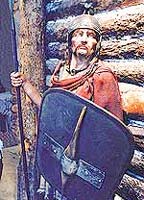Life during the Iron Age may have been brutal, crude, and short-lived, but people of that era still found time to style their hair and groom their nails, activities that were primarily reserved for men.
 |
| Iron Age Men. (Image: hantsmustrust) |
These findings were the result of scientists studying prehistoric remains excavated from a bog in Ireland—the first such discovery in Europe in 20 years.
One of the bodies, found in Clonycavan near Dublin, featured a Mohawk-style haircut (similar to that of Native Americans) and still retained traces of hair gel. The second body was excavated 40 kilometers away at Oldcroghan and had perfectly manicured nails.
“I think the takeaway message is that despite living in a different era, a different culture, consuming different things, and living in different ways, people are still people—they share common thoughts,” stated Rolly Read at the National Museum of Ireland.
Read noted that the latest findings have opened up intriguing insights into life during the Iron Age.
For instance, the hair styling product used by the Clonycavan individuals was a gel made from vegetable oil and pine resin imported from France or Spain. This indicates that trade relations between Ireland and southern Europe existed nearly 2,500 years ago.
Scientists have continually wondered why these mummies ended up in the bog and why many show signs of violence before death, as well as whether they were executed for crimes or were part of sacrificial rituals.
 |
Dr. Eamonn Kelly |
Both the Clonycavan and Oldcroghan men, who were over 20 years old at the time of death, met grisly ends—showing signs of horrific torture, including castration.
Like many other bodies, the Oldcroghan man had been beheaded. Another man still had a rope around his neck.
The well-groomed nails and evidence of a good diet—not to mention the desire for imported cosmetics—suggest that they belonged to an upper-class status.
Eamonn Kelly at the Museum of Ireland has developed a new hypothesis based on the fact that most of the remains were found near the borders of kingdoms or tribal boundaries.
“These individuals could be deposed kings or hostages executed to assert the reign of a new king. This could also be part of rituals offered to the gods,” Kelly remarked.
According to another hypothesis, based on the writings of Roman historian Tacitus, contemptible criminals were thrown into the bog to ensure their souls were trapped in the stagnant water, preventing their bodies from decaying.
M.T


















































